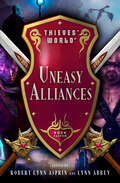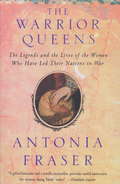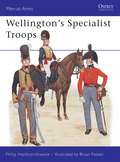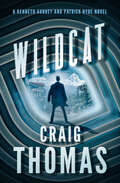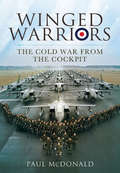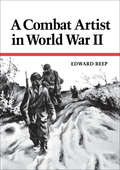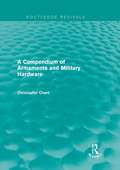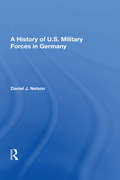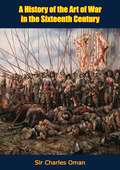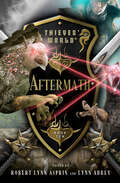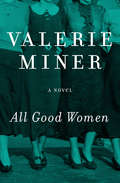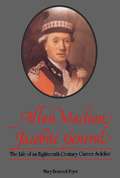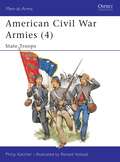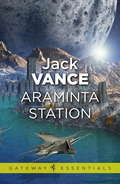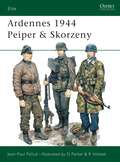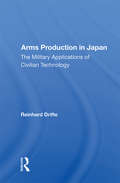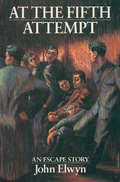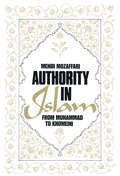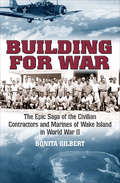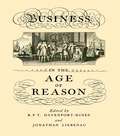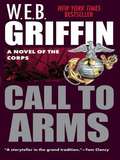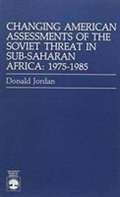- Table View
- List View
Uneasy Alliances (Thieves' World®)
by Diana L. Paxson Chris Morris Robin Wayne Bailey C.J. Cherryh John DeCles C. S. WilliamsThe struggle to rebuild Sanctuary continues in the eleventh entry in this shared-world fantasy series. The storms of war have passed Sanctuary by, and ordinary folk are confident the worst is behind them. Citizens work to restore their lives as the reconstruction brings new life to the city in more ways than one. However, it&’s not sunny skies for everyone. Some residents are opting to settle old debts by the sword, and others are still vanishing off the streets. Meanwhile, Shupansea, ruler of the Beysib, is troubled by bloody nightmares, wondering what they could mean . . . Dive into the action-packed shared world of sword and sorcery, featuring stories by some of fantasy&’s best authors, including Lynn Abbey, Robert Lynn Asprin, C. J. Cherryh, Jon DeCles, Chris Morris, C. S. Williams, Robin W. Bailey, and Diana L. Paxson. &“It&’s a collection to be raced through, to see what will happen. And it&’s a collection to drag one&’s feet through, lest the end come too soon.&” —Fantasy-Faction
Warrior Queens: The Legends and the Lives of the Women Who Have Led Their Nations in War
by Antonia FraserIn this panoramic work of history, Lady Antonia Fraser looks at women who led armies and empires: Cleopatra, Isabella of Spain, Jinga Mbandi, Margaret Thatcher, and Indira Gandhi, among others.
Wellington's Specialist Troops
by Bryan Fosten Philip HaythornthwaiteThe specialist troops of Wellington's army played a crucial role in the success of the British Army. Though often understaffed and ineptly managed, the artillery, engineers, transport and commissariat, and medical services contributed to Wellington's ultimate victory in 1815. The Royal Artillery and Corps of Royal Engineers comprised a small number of highly trained officers, while the commissariat was composed of untrained civilians outside military discipline, and the medical services suffered from a shortage of trained surgeons. This richly illustrated book examines the organization, uniforms and equipment of each of these specialist departments.
Wildcat (The Kenneth Aubrey & Patrick Hyde Series)
by Craig ThomasAn East German officer&’s defection goes fatally awry in this &“adroit, densely plotted spy novel&” by the New York Times–bestselling author (Publishers Weekly). MI6&’s Kenneth Aubrey is on the verge of retirement, but not before he&’s tasked with extracting Kurt Winterbach, an East German intelligence officer who wants to defect—and has valuable military secrets to share. Unfortunately, things go sideways when Brigitte Winterbach, Kurt&’s mother and a high-ranking official in the KGB, prevents his wife and kids from following him. Then, while attempting to flee, Kurt is fatally injured. Aubrey has history with Brigitte, and she already blames him for the long-ago death of her father. Now she&’s lost her son too—and wants revenge. But while she&’s laser-focused on Aubrey, bigger wheels are turning too—and Aubrey&’s adopted son, ex-Ghurka Tim Gardiner, has stumbled upon a plot in Nepal that&’s made him the target of a KGB manhunt . . . &“Another sturdy, reliable thriller for Thomas&’ devoted fans. The aged Aubrey is surprisingly believable as an energetic and successful spy—and there&’s some pleasantly ominous South Asian scenery as well.&” —Kirkus Reviews &“Explosive.&” —Chicago Sun-Times &“When it comes to keeping the story moving and stoking up the excitement, Mr. Thomas knows his business.&” —The New York Times
Winged Warriors: The Cold War from the Cockpit
by Thomas McDonaldPaul McDonald is a former RAF fast-jet pilot whose flying career spanned 34 years. He is not a typical senior RAF officer having been brought up on a council estate in a bleak northern industrial town. He became a pilot by accident and struggled to gain his wings. He spent 14 years on operational tours overseas including 2 tours at the height of the Cold War on a Tornado tactical nuclear squadron in Germany, only 15 minutes from responding to an anticipated Soviet onslaught. Earlier he served on a low-level photo reconnaissance squadron on NATO's vulnerable southern flank. He was decorated for gallantry in 1980 and later served in Kuwait as the Senior RAF Adviser, including Operation Desert Fox, the air war against Iraq in 1998.
Wolfpack Hunting MiGs over Vietnam
by Jerry ScuttsAir-to-air combat was limited in Vietnam compared to the Korean or Second World wars. The author does a credible job of examining the air combat that did take place, examining the tactics, equipment, and the personnel of both sides.
Zoya: An epic, unputdownable read from the worldwide bestseller
by Danielle SteelTHE WORLD'S FAVOURITE STORYTELLERNEARLY ONE BILLION COPIES SOLD One woman's odyssey through a century of turmoil . . . St Petersburg: one famous night of violence in the October Revolution ends the lavish life of the Romanov court forever - shattering the dreams of young Countess Zoya Ossupov.Paris: under the shadow of the Great War, émigrés struggle for survival as taxi drivers, seamstresses and ballet dancers. Zoya flees there in poverty - and leaves in glory.America: a glittering world of flappers, fast cars and furs in the Roaring Twenties; a world of comfort and café society that would come crashing down without warning. An epic and romantic tale from one of the best-loved writers of all time. Perfect for fans of Penny Vincenzi, Lucinda Riley and Maeve BinchyPRAISE FOR DANIELLE STEEL:'Emotional and gripping . . . I was left in no doubt as to the reasons behind Steel's multi-million sales around the world' DAILY MAIL'Danielle Steel is undeniably an expert' NEW YORK TIMES
A Combat Artist in World War II
by Edward ReepA WWII combat artist shares his recollections—and his arresting artwork—from the frontlines of the Italian campaign in this military memoir.Many artists have fought in wars and later recorded heroic scenes of great battles. Yet few artists have created their work on the frontlines as they fought alongside their comrades. Edward Reep, as an official combat artist in World War II, painted and sketched while the battles of the Italian campaign raged around him. At Monte Cassino, the earth trembled as he attempted to paint the historic bombing of that magnificent abbey. Later, racing into Milan with armed partisans on the fenders of his Jeep, he saw the bodies of Mussolini and his beautiful mistress cut down from the gas station where they had been hanged by their heels. That same day he witnessed the spectacle of a large German army force holed up in a high-rise office tower, waiting for the chance to surrender to the proper American brass for fear of falling into the hands of the vengeful partisans.Reep’s recollections of such desperate days are captured in Combat Artist, both in the text and in the many painfully vivid paintings and drawings that accompany it. Reep’s battlefield drawings show us, with unrelenting honesty, the horrors and griefs?and the bitter comedy?of battle.
A Compendium of Armaments and Military Hardware (Routledge Revivals)
by Christopher ChantFirst published in 1987, The Compendium of Armaments and Military Hardware provides, within a single volume, the salient technical and operational details of the most important weapons. The complete range of hardware used in land, sea and air forces throughout the world at the time of publication is covered, from tanks to rocket systems, helicopters to cruise missiles, alongside full details of size, weight and operational range. The book’s main strength lies in the detail it gives of armament and associated ammunition capabilities, and of the sensors and other electronics required for the weapons to be used effectively. A key title amongst Routledge reference reissues, Christopher Chant’s important work will be of great value to students and professionals requiring a comprehensive and accessible reference guide, as well as to weapons ‘buffs’.
A History Of U.s. Military Forces In Germany
by Daniel J. NelsonDiscussing why the U.S. will remain in the FRG for the foreseeable future, this book examines the U.S. military presence in Germany. It shows how that presence has affected the development of the political and diplomatic relationship between the two countries.
A History of the Art of War in the Sixteenth Century: A History Of The Art Of War In The Sixteenth Century (1937) (Routledge Revivals)
by Charles OmanTHE BEST ACCOUNT OF SIXTEENTH-CENTURY WARFARE BY THE AUTHOR OF A HISTORY OF THE PENINSULAR WARThis is an unrivalled account of sixteenth-century warfare, in which Sir Charles Oman traces the dramatic, far-reaching changes in the military strategy, tactics and organization of the period.Showing how warfare developed, he covers the Great Wars of 1949-1559; military events in Tudor England, including Henry VIII’s continental wars; the French Wars of Religion, 1562-98; the Dutch revolt and war of independence, 1568-1603; and the Turkish offensive against Christendom, from 1520 until the Peace of Sitva Torok in 1606.The battles, sieges and campaigns that Oman examines in detail clarify military development across the century, such as Ravenna (1512), the first battle won by dominance in artillery; Pavia (1525), a ‘victory by surprise’; Pinkie (1547), where an old-fashioned infantry army proved helpless against the combination of all arms; and Arques (1589), exemplifying the defence of a defile by very inferior number.Contemporary maps illustrate many of the actions, and add to the value of this brilliant and lucid history of the art of war.Sir Charles Oman was one of Britain’s foremost historians and a gifted writer. His books, noted for being both scholarly and accessible, include the two-volume History of the Art of War in the Middle Ages, the seven-volume A History of the Peninsular War and others.
Aftermath (Thieves' World®)
by John Brunner David Drake andrew j. offuttThe mercenary Stepsons leave Sanctuary behind in this tenth volume of the shared-world fantasy anthology series. As Tempus and his mercenary army, the Stepsons, depart from war-torn Sanctuary, there are some who view it as a return to normal. Yet what is normal in this city of thieves and adventurers? Laborers arrive to help in the rebuilding efforts, but some of these able-bodied men are disappearing. An assassin seeks revenge for his brother, and others aim to instill peace in the community while vicious rivalries emerge from Sanctuary&’s rubble. And a struggle for power seems to be brewing . . . If this is your kind of &“normal,&” then enter an action-packed world of sword and sorcery in this shared-world anthology featuring stories by some of fantasy&’s best authors: Robert Lynn Asprin, Mark C. Perry, Janet Morris, David Drake, John Brunner, Lynn Abbey, and Andrew Offutt.
All Good Women: A Novel
by Valerie MinerAs World War II rages abroad, a group of women forge the bonds of sisterhood in AmericaIn 1938, while tensions in Europe are reaching a boiling point, four young women with big ambitions enter secretarial school in San Francisco. Motivated to attain the financial stability that eluded their parents, they go to battle for their futures. Moira, of Scottish descent, dreams of being an actress. Ann yearns for the education her Jewish immigrant parents provided for her brother, but not for her. Japanese American Wanda experiences firsthand the racial injustices running rampant in the United States. And Teddy, who left the Dust Bowl for sunny California, comes to startling realizations about herself as the war progresses. These women will be both buoyed and challenged by their dreams, experiencing love, loss, and everything in between. Against the backdrop of a nation gripped by fear and paranoia, Miner eloquently captures the spirit of wartime on the home front.
Allan Maclean, Jacobite General: The life of an eighteenth century career soldier
by Mary Beacock FryerBorn on the Isle of Mull to an impoverished lair of the clan Maclean, young Allan fought his first battle — for Bonnie Prince Charlie at Culloden — from a sense of deep conviction and family loyalty. He fled into exile when the Stuart cause was lost. In Holland he became a mercenary, and after amnesty was granted for Jacobites, he joined the British army serving in North America during the Seven Years’ War, and again during the American Revolution. He was at Quebec on New Year’s Eve 1775 when the city was attacked by Benedict Arnold, and shortly thereafter become the military governor of Montreal. Between the two wars, when the army was reduced and he was on half-pay, Maclean was preoccupied with finding ways to meet the expenses he incurred while on active service. He made himself useful to politicians and office-holders who had access to public funds or who could recommend him for promotions. One who helped him was Lauchlin Macleane, an ambitious politician who was probably the notorious Junius, who wrote vicious letters to newspapers attacking the government, but was never unmasked. This fast-paced and intriguing book gives a penetrating insight into the challenges facing a man who chose a military career during the tumultuous period of the eighteenth century.
American Civil War Armies
by Ronald Volstad Philip KatcherAt the time of the American Civil War (1861-1865), with two million men under arms, a US Army that in pre-war days had depended upon a minute number of technical troops now required virtually an army of specialists alone. Special sharpshooters were recruited for skirmishing duty; men whose wounds would have led to their discharge in the past now found themselves guarding important posts in the Veteran Reserve Corps; and large numbers of civilians found themselves in uniform as members of the Telegraph or Hospital Corps. Philip Katcher examines the organization and uniforms of the specialist troops who served in the armies of both sides.
Araminta Station (Gateway Essentials #196)
by Jack VanceTravel out along the galaxy's Perseid Arm. Branch off to follow the ten thousand stars of Mircea's Wisp. Eventually you will come to the Purple Rose System - three stars, Lorca, Sing and Syrene, that seem about to drift away into the void. Three planets circle Syrene. On one, Cadwal, there is Life. Long ago the Naturalist Society of Earth had listed Cadwal as a natural preserve. An administration centre had been set up and staffed to protect the planet from all exploitation. Araminta Station. Now, centuries later, the young Glawen Clattuc is beginning to wonder what the future may hold for him in the hierarchic, carefully ordered hereditary society that is life on Cadwal.
Ardennes 1944 Peiper & Skorzeny
by David Parker Jean-Paul PalludFrom the earliest planning stages of the German counter-offensive in the Ardennes during World War II (1939-1945), Hitler was convinced of the importance of taking the Meuse bridges. He resolved that, when his forces broke through the US lines, one special unit should be dressed in American uniforms and issued with American weapons and vehicles. In this guise they could take advantage of the surprise and shock of the breakthrough, and move forward to the Meuse bridges as if they were retreating Americans. Jean-Paul Pallud details their organisation and the fateful sequence of events that followed.
Arms Production In Japan: The Military Applications Of Civilian Technology
by Reinhard DrifteAlthough Japan's arms industry is still relatively small, significant political, economic, and technological developments indicate its growing importance and pave the way for Japan's increasing involvement in arms production. In this comprehensive study, Dr. Drifte examines both the domestic and international environments that are encouraging Japan
At the Fifth Attempt: An Escape Story
by John ElwynThis tells the story of a soldier caught before the evacuation at Dunkirk, and his daring escape and life along the way.
Authority in Islam: From Mohammed to Khomeini
by Mehdi MozaffariThis text looks at the future orientation of the People's Liberation Army. It covers military leadership, readiness and expenditure, defense doctrine, high-tech warfare acquisitions, the scientific and technological base for defense procurement and China's security concerns in Northeast Asia.
Breaking the Ring
by John BarronThe bizarre case of the espionage operation of the John Walker family and the U.S. government's hunt for the spy and his accomplices.
Building for War: The Epic Saga of the Civilian Contractors and Marines of Wake Island in World War II
by Bonita GilbertThe story of the Americans who came under attack five hours after Pearl Harbor was hit: &“Intriguing, informative, gripping, and at times very moving&” (Naval Historical Foundation). This intimately researched work tells the story of the thousand-plus Depression-era civilian contractors who came to Wake Island, a remote Pacific atoll, in 1941 to build an air station for the US Navy—charting the contractors&’ hard-won progress as they scramble to build the naval base, as well as runways for US Army Air Corps B-17 Flying Fortresses, while war clouds gather over the Pacific. Five hours after their attack on Pearl Harbor, the Japanese struck Wake Island, which was now isolated from assistance. The undermanned Marine Corps garrison, augmented by civilian-contractor volunteers, fought back against repeated enemy attacks, at one point thwarting a massive landing assault. The atoll was under siege for two weeks as its defenders continued to hope for the US Navy to come to their rescue. Finally succumbing to an overwhelming amphibious attack, the surviving Americans, military and civilian, were taken prisoner. While most were shipped off to Japanese POW camps for slave labor, a number of the civilians were retained as workers on occupied Wake. Later in the war, the last ninety-eight Americans were brutally massacred by their captors. The civilian contractors who had risked distance and danger for well-paying jobs ended up paying a steep price: their freedom and, for many, their lives. Written by the daughter and granddaughter of civilians who served on Wake Island, Building for War sheds new light on why the United States was taken by surprise in December 1941, and shines a spotlight on the little-known, virtually forgotten story of a group of civilian workers and their families whose lives were forever changed by the events on this tiny atoll.
Business in the Age of Reason
by R.P.T. Davenport-Hines Jonathan LiebenauFirst Published in 1987. Routledge is an imprint of Taylor & Francis, an informa company.
Call to Arms (Corps #2)
by W.E.B. GriffinThe attack on Pearl Harbor swept America into the raging heart of the war. The stormy South Pacific presented a daring new challenge, and the men of the Corps were ready to fight. An elite fraternity united by a glorious tradition of courage and honor, the Marine Raiders were bound to a triumphant destiny. Now, the bestselling author of the acclaimed BROTHERHOOD OF WAR saga continues the epic story begun in Semper Fi. A story of lovers and fighters, leaders and heroes--the men of the United States Marine Corps...
Changing American Assessments of the Soviet Threat in Sub-Saharan Africa, 1975-1985
by Donald JordanThis work categorizes various American images of the Soviet threat in Africa and traces them over time. Four different images are examined: the alarmist, the globalist, the regionalist, and the confident regionalist. Jordan points to the importance of understanding what these images are and how they influence and determine U.S. foreign policy decisions. Will be useful to strategic theorists, Africanists, and analysts of U.S. foreign policy.
